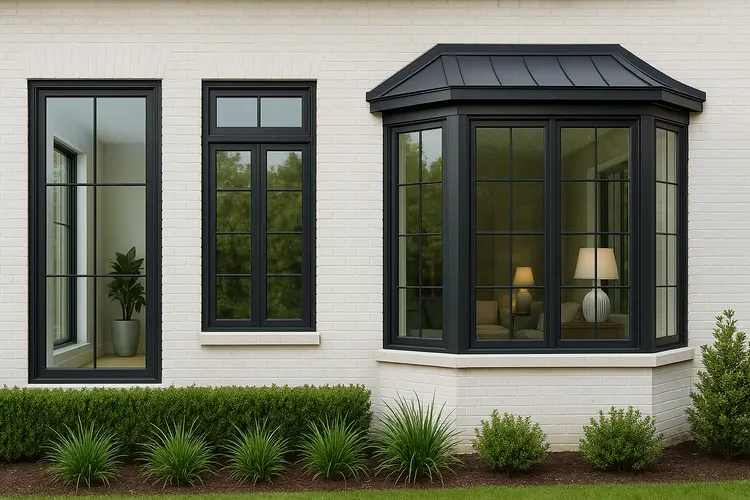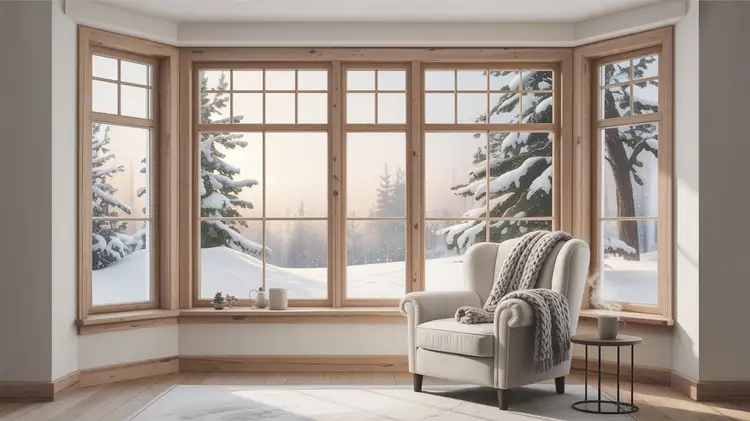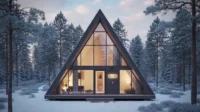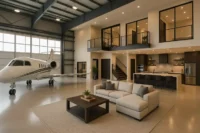Best Window Design for Home | Stylish & Modern Ideas
Published: 31 May 2025
Introduction
Home architecture relies heavily on windows since they determine both the external appearance and internal energy conservation and create the atmosphere of each room. The suitable choice of windows creates dramatic results which enhance both the external aesthetics and internal comfort of a building. This extensive guidance presents several current and elegant window styles together with essential information that residents need to make window selection choices.
1. Floor-to-Ceiling Windows: Embracing Openness
1.1 Enhancing Natural Light
Window walls extending from flooring to ceiling heights offer buildings the ability to receive magnificent amounts of sunlight while merging interior and exterior spaces. The implementation of this window style eliminates artificial lighting necessity and brings an experience of being in touch with nature through its open design.

1.2 Seamless Indoor-Outdoor Transition
The extensive windowpanes merge interior areas with landscapes while creating unrestricted sightlines between inside and outside. The architectural style functions best when a living space shares an open connection with outdoor gardens or patios.
1.3 Considerations for Privacy and Glare
The many advantages of floor-to-ceiling windows require people to devise solutions for privacy needs and manage exterior light reflections. Tinted glass combined with sheer curtains and the appropriate strategic landscape treatments provide solutions to these issues.
Design Idea | Description | Style Tip |
Clerestory Windows | Placed high on walls to let in light while maintaining privacy. | Perfect for bathrooms, hallways, or vaulted ceilings. |
Corner Glass Windows | Wrap around corners for panoramic garden or city views. | Use seamless frames to highlight the modern design. |
Pivot Windows | Rotates on a central axis for unique functionality and airflow. | Great for modern or industrial home aesthetics. |
Stained Glass Panels | Adds color and artistry while maintaining privacy and charm. | Best used in entryways or bathrooms for a vintage touch. |
2. Casement Windows: Classic Meets Contemporary
2.1 Superior Ventilation
Casement windows operate alongside doors because they hinge from the sides to expose their exterior area. The window design allows maximal ventilation because the entire window opening functions for fresh air entry.
2.2 Energy Efficiency
Casement windows achieve complete energy efficiency when they are sealed shut because they create a tight barrier against outside drafts. Such-windows offer great advantages for maintaining steady indoor heat levels.
2.3 Versatile Aesthetics
Homeowners choose casement windows because their designs featuring straight contours together with minimal hardware work with a wide range of traditional and contemporary house styles.
3. Double-Hung Windows: Timeless Functionality
3.1 Flexible Ventilation Options
Double-hung windows include two sections which move vertically together. Homeowners maintain air circulation control through the ability to open their double-hung windows at either the top or bottom or as a whole to achieve effective indoor ventilation.
3.2 Ease of Maintenance
Modern double-hung windows include features that allow users to tilt their sashes for easier window cleaning and improved convenience when maintaining the windows.
3.3 Space-Saving Design
A double-hung window design works well for outdoor views and patios since its vertical operating mechanism does not extend beyond the window frame space.andersenwindows.com + 1bhg.com + 1

4. Sliding Windows: Sleek and Space-Efficient
4.1 Contemporary Appeal
Sliding windows are made of one stationary glass pane along with a horizontally moving window panel. The modern window design matches well with contemporary architectural trends created by its sleek appearance.
4.2 Unobstructed Views
Sliding windows feature basic frames that create extensive undisturbed outdoor views which enable homeowners to better observe their external surroundings.
4.3 Low Maintenance
Sliding window systems have straightforward mechanisms which reduce the number of parts that could deteriorate thereby reducing long-term maintenance needs.
5. Awning Windows: Practical and Stylish
5.1 All-Weather Ventilation
The top section of an awning window has a hinge mechanism that allows it to open outward and present an awning shape. Ventilation remains possible in light rain through this design since the glass pane protects the opening from moisture.
5.2 Enhanced Privacy
The positioning of these windows at wall heights enables light entrance while giving privacy protection so they function ideally in bathroom and bedroom spaces.
5.3 Complementary Design
The combination of larger stationary windows with awning windows produces a harmonious window design which increases style and operational capabilities.
Design Idea | Description | Style Tip |
Floor-to-Ceiling Windows | Provides expansive views and enhances natural lighting. | Use sheer curtains for privacy without blocking light. |
Bay Window with Seating | Creates a cozy nook with built-in seating and charm. | Add cushions and storage drawers below the seat. |
Sliding Glass Windows | Ideal for ventilation and modern compact spaces. | Pair with minimalist interiors for clean aesthetics. |
Arched Accent Windows | Adds architectural elegance and timeless appeal. | Frame with contrasting trim to highlight the curve. |
6. Picture Windows: Framing the Outdoors
6.1 Maximizing Natural Light
Picture windows have a large fixed form which serves to display outdoor scenes while offering a panoramic view of natural landscapes. These window types enable complete access to external daylight which produces illuminated and welcoming interior areas.
6.2 Energy Efficiency
The non-operable feature of picture windows creates optimal insulation which results in better energy efficiency by preventing air leakage.

6.3 Creating Focal Points
Survey the living room or dining area along with bedroom spaces to find the best positions for picture windows that will enhance certain exterior views.
7. Bay and Bow Windows: Adding Dimension
7.1 Expanding Interior Space
The projection of bay and bow windows outside home walls creates useful interior space that becomes either seating areas or item display spaces.
7.2 Architectural Interest
The architectural profiles of these windows enhance exterior visual appeal to create specific wall aesthetics which boost home curb appeal and aesthetic uniqueness.
7.3 Panoramic Views
Due to their angled structure bay and bow windows deliver extensive outdoor views that let homeowners see their environment in wider dimensions.
8. Skylights: Illuminating from Above
8.1 Enhancing Natural Light
The home utilizes skylights positioned in the roof area to let natural light shine through from the upper part of the structure. Shadowy interiors benefit greatly from the use of these windows because they receive no direct sunlight due to their placement on exterior walls.
8.2 Energy Savings
Skylights help save energy because they remove the requirement for artificial light exposure to indoor spaces throughout daytime hours which results in a more sustainable building strategy.
8.3 Ventilation Options
Built for opening and closing operation these skylights provide ventilation capabilities that enhance room air quality particularly in rooms such as kitchens and bathrooms.

9. Clerestory Windows: Elevating Design
9.1 Architectural Enhancement
Clerestory windows refer to horizontal windows that sit high on the walls adjacent to the roof. Such windows serve as distinct architectural features to raise both aesthetic appeal and home design quality.
9.2 Balanced Lighting
The light entry through clerestory windows creates balanced illumination throughout a space meaning householders require fewer lighting fixtures thus fostering improved ambiance.
9.3 Privacy Preservation
These higher-set elements enable houses to receive natural illumination without jeopardizing privacy so residents get the benefit of both light and discretion in their space.
10. Corner Windows: Expanding Perspectives
10.1 Seamless Indoor-Outdoor Connection
Window systems that embrace two adjacent walls offer complete landscape views from their corner position. The placement of these windows throughout the house enables natural illumination to flow while giving spaces an open modern appearance.
10.2 Architectural Elegance
Contemporary designs benefit from such windows which bring modern style along with their elegant look. Their unobstructed design allows homeowners to see each exterior landscape through their windows which particularly suits houses located near scenic views.
10.3 Customization Options
The framework of corner windows depends on architectural style since they require either frameless construction or use slim metal support structures. The integration of automatic blinds gives users the ability to manage privacy needs in these window designs.
11. Black-Framed Windows: Bold and Modern
11.1 High-Contrast Appeal
A home benefits from black-framed windows when these frames contrast against light walls since they produce a sophisticated upscale look.
11.2 Compatibility with Various Styles
The implementation of black-framed windows in all styles of interiors creates powerful design elements that serve as dominant design features.
11.3 Durability and Low Maintenance
Black frames constructed from aluminum or steel remain durable through all weather conditions and need very little maintenance.
12. Frosted and Textured Glass: Enhancing Privacy
12.1 Enhancing Privacy without Blocking Light
The passing of sunlight through frosted and textured glass products creates a concealed view area. The material works perfectly well for creating window designs which protect privacy in bathrooms and entryways as well as home offices.
12.2 Modern and Decorative Appeal
Textured glass windows feature different decorative patterns which create artistic window designs but conserve privacy at all times.
12.3 Customization for Different Needs
Homeowners obtain privacy without blocking light from their spaces by selecting either complete or partial frosted glass window options.

13. Energy-Efficient Windows: Sustainable and Cost-Saving
13.1 Double and Triple Glazing for Insulation
Multiple glass layers in windows work together to decrease heat flow which enhances both household energy efficiency and solid temperature control.
13.2 Low-E Glass for UV Protection
Furniture and flooring stay protected from fading with Low-E coatings which help heat regulation through blocking of damaging UV rays.
13.3 Smart Glass Technology
A homeowner can benefit from electrochromic smart glass technology because it enables them to manage their window transparency in order to achieve privacy control and energy savings.
14. Smart Windows: The Future of Home Design
14.1 Automated Tinting for Comfort
The opacity of smart windows responds to sunlight levels to prevent indoor overheating and reduce bright lighting.
14.2 Remote and Voice-Control Integration
Users can access and control their smart windows through mobile apps or voice command systems which provides enhanced performance and eliminates expenditure on utility bills.
14.3 Security and Efficiency
The incorporation of built-in sensors within smart windows allows for increased safety and enhanced efficiency because they both control ventilation and report window breakage.
FAQs
Best Window Design to Maximize Natural Lighting?
The combination of windows from floor to ceiling along with skylights and clerestory windows serves as an excellent design choice to maximize natural light in houses.
Best Window for Energy Efficiency?
A customer should select double-glazed windows with Low-E coatings as these produce the best energy performance among window systems.
Best Insulation Window System?
Stacking two panes of glass and Low-E coating on windows provides superior insulation against heat loss while conserving energy.
How to Select the Right Window Type?
Architectural style together with climate conditions and required functionality should determine the type of window design most suitable for the home.

- Be Respectful
- Stay Relevant
- Stay Positive
- True Feedback
- Encourage Discussion
- Avoid Spamming
- No Fake News
- Don't Copy-Paste
- No Personal Attacks

- Be Respectful
- Stay Relevant
- Stay Positive
- True Feedback
- Encourage Discussion
- Avoid Spamming
- No Fake News
- Don't Copy-Paste
- No Personal Attacks





